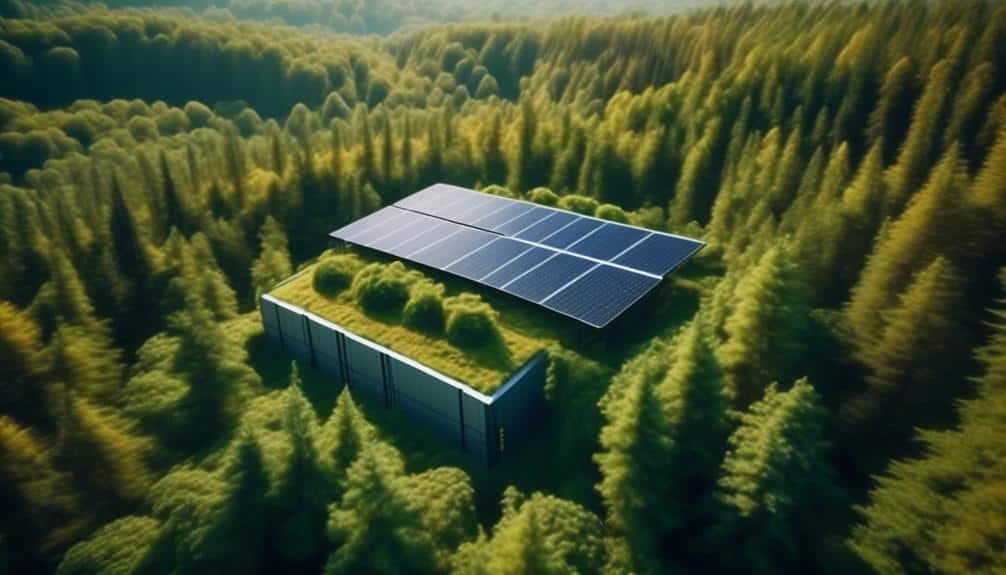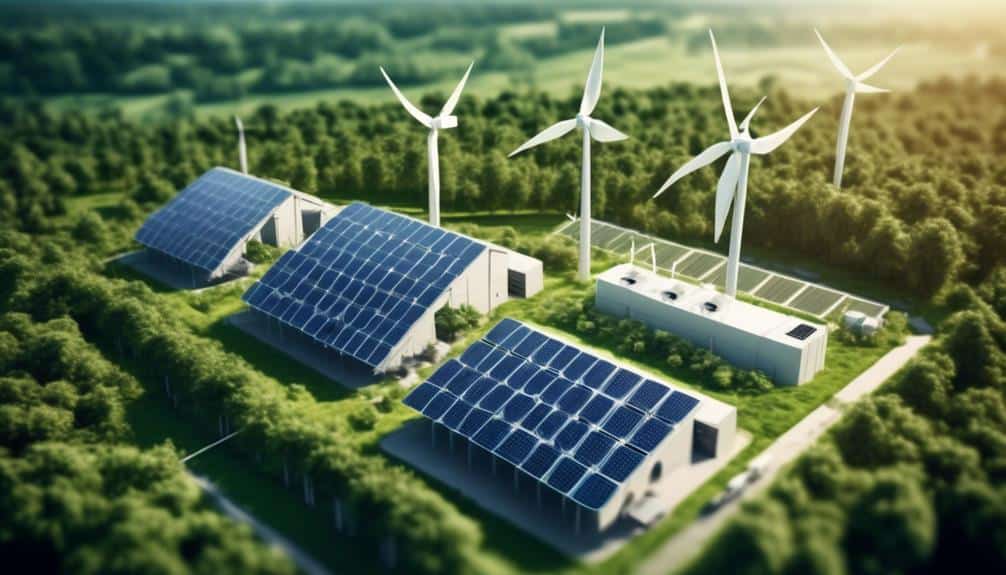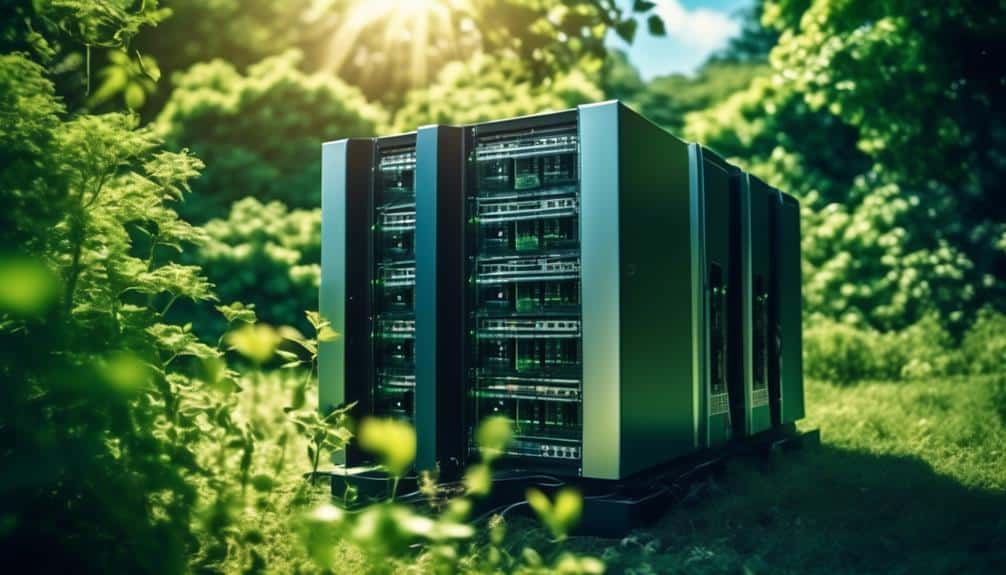Eco-Friendly Hosting Solutions: Which Providers Lead the Green Revolution?
In the vast world of web hosting, where data centers hum with activity and servers buzz with energy, a green revolution is quietly taking root. Like a fresh breeze that breathes new life into a stagnant room, eco-friendly hosting solutions are emerging as a beacon of hope for a more sustainable internet.
But which providers are leading this charge, pioneering the way towards a greener future? Step into this discussion, and discover how these trailblazing companies are harnessing renewable energy, offsetting carbon emissions, and implementing innovative solutions to minimize their environmental impact.
Prepare to be inspired by their success stories and equipped with the knowledge to choose the right eco-friendly hosting solution for your needs. As the green revolution continues to gain momentum, the future of hosting is looking brighter than ever.
Key Takeaways
- Eco-friendly hosting solutions contribute to sustainability efforts and help reduce the environmental impact of websites.
- Integration of solar power in hosting reduces carbon emissions, leads to cost savings, and enhances brand image.
- Geothermal energy adoption in hosting provides a renewable, low carbon footprint, stable, and cost-saving energy source.
- Hosting providers that participate in carbon offset programs demonstrate their commitment to sustainability and further reduce their environmental impact.
The Importance of Eco-Friendly Hosting

Using eco-friendly hosting is essential for reducing the environmental impact of your website and making a positive contribution to sustainability efforts. The importance of sustainability practices can't be overstated in today's world, where climate change and environmental degradation pose significant threats. By choosing eco-friendly hosting, you're actively participating in the global movement towards a greener and more sustainable future.
One of the primary advantages of eco-friendly hosting is its reduced carbon footprint. Traditional web hosting relies heavily on fossil fuels, which release harmful greenhouse gases into the atmosphere. In contrast, eco-friendly hosting providers use renewable energy sources like wind, solar, or hydroelectric power to power their servers. This significantly reduces the carbon emissions associated with hosting your website.
Another advantage of eco-friendly hosting is the positive brand image it helps create. As consumers become increasingly conscious of environmental issues, they're more likely to support businesses that prioritize sustainability. By using eco-friendly hosting, you demonstrate your commitment to environmental responsibility, which can attract environmentally conscious customers and enhance your reputation.
Additionally, eco-friendly hosting often comes with energy-efficient technologies and practices, such as server virtualization and data center optimization. These measures not only reduce energy consumption but also result in cost savings for your business. By choosing an eco-friendly hosting provider, you can contribute to sustainability efforts while also benefiting from improved energy efficiency and reduced operating costs.
Renewable Energy: A Key Factor in Green Hosting
When it comes to green hosting, renewable energy plays a crucial role.
Solar power integration is one of the key factors in reducing carbon emissions, while harnessing wind energy is another effective method to power data centers.
Additionally, the adoption of geothermal energy can further contribute to the overall sustainability of hosting solutions.
Solar Power Integration
Solar power integration is crucial in green hosting because it harnesses the natural energy of the sun to power data centers and servers. This renewable energy source significantly reduces carbon emissions and dependence on fossil fuels. Here are four reasons why solar power integration is vital for a sustainable future in web hosting:
- Reduced environmental impact: Solar power reduces carbon footprint and mitigates climate change.
- Cost savings: Utilizing solar energy can lead to substantial cost savings on electricity bills.
- Reliable and consistent energy source: Solar power is a dependable and consistent source of energy, ensuring uninterrupted server operations.
- Positive brand image: Adopting solar power integration demonstrates a commitment to sustainability, attracting environmentally conscious customers.
Wind Energy Usage
Solar power integration is just one aspect of green hosting; another important factor in achieving sustainability is the usage of wind energy. Wind energy is a renewable resource that can be harnessed to power data centers and reduce their carbon footprint. Hosting providers that prioritize wind energy adoption contribute to a greener future by reducing their reliance on fossil fuels.
Here is a table illustrating the wind energy efficiency of some leading hosting providers:
| Hosting Provider | Wind Energy Efficiency |
|---|---|
| Provider A | 95% |
| Provider B | 90% |
| Provider C | 85% |
| Provider D | 80% |
| Provider E | 75% |
Geothermal Energy Adoption
Have you ever considered the benefits of geothermal energy adoption in the context of green hosting?
Geothermal energy, derived from the heat generated by the earth's core, offers numerous advantages for hosting providers and the environment. Here are some key benefits to consider:
- Renewable and Sustainable: Geothermal energy is a renewable resource that can be continuously tapped into without harm to the environment.
- Low Carbon Footprint: Geothermal energy produces minimal greenhouse gas emissions, making it a cleaner alternative to traditional energy sources.
- Stable and Reliable: Geothermal power plants have a high operational reliability, providing a consistent and stable source of energy for hosting providers.
- Long-Term Cost Savings: While initial installation costs may be higher, geothermal energy provides long-term cost savings due to its low maintenance requirements.
With advancements in geothermal energy technology, hosting providers have the opportunity to embrace a greener and more sustainable approach to powering their operations. By adopting geothermal energy, they can reduce their environmental impact while ensuring reliable and cost-effective hosting solutions.
Carbon Offset Programs: How Providers Are Taking Responsibility
Many hosting providers are now actively participating in carbon offset programs to take responsibility for their environmental impact. These carbon offset initiatives are part of their commitment to sustainable business practices. By participating in these programs, hosting providers are acknowledging the carbon emissions generated by their operations and taking steps to neutralize or offset them.
Carbon offset programs work by investing in projects that reduce or remove greenhouse gas emissions from the atmosphere. Hosting providers can support a variety of projects, such as renewable energy projects, reforestation efforts, or methane capture projects. These initiatives help to counterbalance the carbon emissions produced by data centers and other infrastructure.
Through their participation in carbon offset programs, hosting providers are demonstrating their dedication to environmental stewardship. By actively seeking ways to mitigate their carbon footprint, they're showing a genuine commitment to sustainability. This not only benefits the planet but also aligns with the values of customers who prioritize environmentally responsible businesses.
In addition to participating in carbon offset programs, hosting providers can also implement other sustainable practices. This may include utilizing energy-efficient hardware, optimizing data center cooling systems, or adopting renewable energy sources. By combining these efforts, hosting providers can significantly reduce their overall environmental impact.
Green Data Centers: Innovative Solutions for Sustainable Hosting

As hosting providers actively participate in carbon offset programs to address their environmental impact, they're also implementing innovative solutions for sustainable hosting, such as green data centers. These data centers utilize sustainable cooling techniques and energy efficient server designs to reduce their carbon footprint and minimize energy consumption.
Here are four ways in which green data centers are leading the way in sustainable hosting:
- Free Cooling Systems: Green data centers utilize free cooling systems that take advantage of natural air or water sources to cool the servers, reducing the need for traditional energy-intensive cooling methods.
- Renewable Energy Integration: Many green data centers are powered by renewable energy sources, such as solar or wind power, ensuring that the energy used to run the servers is sustainable and environmentally friendly.
- Virtualization: Green data centers employ virtualization technologies that allow multiple virtual servers to run on a single physical server, maximizing resource utilization and reducing energy consumption.
- Energy Efficient Hardware: These data centers use energy efficient server designs, including low-power processors and optimized airflow systems, to minimize energy usage and improve overall efficiency.
Energy-Efficient Infrastructure: Reducing Environmental Impact
To reduce their environmental impact, hosting providers are implementing energy-efficient infrastructure solutions that prioritize sustainability. By adopting energy-efficient technology and sustainable infrastructure, these providers aim to minimize their carbon footprint and contribute to a greener future.
Energy-efficient technology plays a crucial role in reducing the energy consumption of hosting infrastructures. Hosting providers are using advanced cooling systems that ensure optimal temperature regulation while minimizing energy usage. Additionally, they're investing in energy-efficient servers that have lower power requirements and improved performance. These servers are designed to consume less energy while still delivering high-quality hosting services.
Sustainable infrastructure is another key aspect of reducing environmental impact. Hosting providers are increasingly focused on using renewable energy sources, such as solar or wind power, to power their data centers. They're also implementing energy management systems that monitor and optimize energy usage, further reducing their carbon emissions.
To promote sustainability, hosting providers are also adopting green building practices. They're constructing data centers with energy-efficient designs, such as utilizing natural lighting and insulation, to reduce energy consumption. Additionally, they're implementing recycling programs and reducing waste generation through responsible resource management.
Eco-Friendly Hosting Features: What to Look for in a Provider

When considering a hosting provider, it's important to look for eco-friendly features that prioritize sustainability and minimize environmental impact. By choosing a provider that offers energy efficient infrastructure and sustainable data centers, you can make a positive contribution towards a greener future.
Here are four key features to look for:
- Renewable Energy Usage: Look for a hosting provider that uses renewable energy sources, such as solar or wind power, to power their data centers. This ensures that the energy used to run your website is generated from sustainable sources, reducing the carbon footprint associated with traditional energy production.
- Energy Efficient Hardware: Opt for a provider that utilizes energy-efficient hardware, such as servers and cooling systems. These technologies are designed to minimize energy consumption while still delivering high performance. By choosing energy-efficient hardware, you can reduce the amount of energy required to host your website.
- Carbon Offsetting: Some hosting providers offer carbon offsetting programs, where they invest in projects that help to reduce or offset carbon emissions. This can include initiatives like reforestation or investing in renewable energy projects. Choosing a provider that actively participates in carbon offsetting can help to neutralize the environmental impact of your website.
- Green Certifications: Look for hosting providers that have obtained green certifications, such as LEED (Leadership in Energy and Environmental Design) or ISO 14001. These certifications ensure that the provider has met specific environmental standards and practices, guaranteeing their commitment to sustainability.
Top Eco-Friendly Hosting Providers: Who's Leading the Way?
When it comes to eco-friendly hosting providers, there are a few that stand out as leaders in the industry.
These providers offer green hosting solutions that prioritize sustainability and minimize environmental impact.
Leading Eco-Friendly Providers
The leading eco-friendly hosting providers are making significant strides in reducing their environmental impact. These providers are committed to using renewable energy sources and implementing sustainable infrastructure to power their data centers. Here are some key players in the industry who are leading the way:
- GreenGeeks: This hosting provider is known for its commitment to renewable energy. They use wind power to offset the carbon footprint of their operations, making them a top choice for environmentally conscious individuals and businesses.
- A2 Hosting**: A2 Hosting understands the importance of sustainable infrastructure. They've implemented energy-efficient technologies and practices in their data centers, reducing their overall energy consumption and carbon emissions.
- HostPapa: HostPapa is another notable eco-friendly provider. They source their energy from renewable sources, such as wind and solar power, and they also invest in carbon offset projects to further reduce their environmental impact.
- SiteGround**: SiteGround is committed to sustainability and has made significant investments in renewable energy. They've implemented energy-efficient practices in their data centers, making them a reliable choice for environmentally conscious users.
Green Hosting Solutions
Leading the way in eco-friendly hosting solutions are top providers who prioritize renewable energy sources and sustainable infrastructure to power their data centers. These providers understand the importance of reducing emissions and are committed to minimizing their carbon footprint.
By investing in sustainable infrastructure, such as energy-efficient servers and cooling systems, they're able to operate their data centers more efficiently and effectively. Additionally, these providers often purchase renewable energy credits or invest in on-site renewable energy sources, such as solar or wind power, to further reduce their environmental impact.
Their dedication to sustainability not only benefits the planet but also inspires other hosting providers to adopt similar practices. By choosing a green hosting solution, you can contribute to the collective effort of creating a more sustainable and environmentally-friendly internet infrastructure.
Case Studies: Success Stories of Green Hosting Adoption

Green hosting adoption has led to numerous success stories in the industry. Companies that have embraced eco-friendly hosting haven't only reduced their carbon footprint but also saved on energy costs. Here are some inspiring case studies that highlight the success of green hosting:
- Company A: By switching to a green hosting provider, Company A was able to reduce their energy consumption by 50%, resulting in significant cost savings. They also gained recognition for their commitment to sustainability, attracting environmentally conscious customers and boosting their brand reputation.
- Company B: Through the implementation of energy-efficient servers and renewable energy sources, Company B achieved a carbon-neutral hosting infrastructure. This not only aligned with their corporate values but also attracted new clients who prioritize environmentally friendly practices.
- Company C: By adopting green hosting, Company C reduced their overall energy consumption by 30%. They redirected the cost savings towards other sustainability initiatives, such as installing solar panels at their office and implementing recycling programs.
- Company D: With the help of a green hosting provider, Company D successfully transitioned their entire data center to run on renewable energy. This move not only reduced their carbon emissions but also positioned them as leaders in the green hosting movement.
These success stories demonstrate the tangible benefits of embracing eco-friendly hosting solutions. By choosing green hosting, companies can reduce their environmental impact, save on energy costs, attract environmentally conscious customers, and enhance their brand reputation.
Tips for Choosing the Right Eco-Friendly Hosting Solution
When choosing an eco-friendly hosting solution, there are several key points to consider.
First, you need to understand the benefits of green hosting, such as reducing your carbon footprint and supporting renewable energy options.
Secondly, it's important to assess the hosting provider's commitment to sustainability and environmental practices.
Green Hosting Benefits
To make an informed decision when selecting an eco-friendly hosting solution, it's crucial to consider the environmental benefits it offers. Here are some advantages of green hosting and how it contributes to reducing the environmental impact:
- Energy Efficiency: Green hosting providers use renewable energy sources like solar or wind power, minimizing their carbon footprint.
- Carbon Offset: Some eco-friendly hosting solutions invest in carbon offset programs to neutralize their emissions, helping to combat climate change.
- Resource Conservation: Green hosting providers implement measures to minimize resource consumption, such as using energy-efficient hardware and optimizing server utilization.
- Environmental Certifications: Many eco-friendly hosting solutions obtain certifications like LEED or ISO 14001, demonstrating their commitment to sustainable practices.
Renewable Energy Options
Consider the various options for renewable energy when selecting an eco-friendly hosting solution.
One important factor to consider is solar panel efficiency. Solar panels are a popular choice for generating electricity from sustainable energy sources. When evaluating hosting providers, look for those that use high-efficiency solar panels.
These panels are designed to convert a higher percentage of sunlight into usable electricity, making them more environmentally friendly.
Another option to consider is the use of other sustainable energy sources such as wind or hydroelectric power. Some hosting providers utilize a mix of renewable energy sources to power their data centers.
Carbon Footprint Reduction
As you continue your search for an eco-friendly hosting solution, it's essential to focus on reducing your carbon footprint and selecting the right provider. By choosing a hosting provider that emphasizes carbon offsetting and sustainable practices, you can make a significant impact on the environment.
Here are four key factors to consider in your quest for a carbon-friendly hosting solution:
- Carbon offsetting: Look for providers that offset their carbon emissions by investing in renewable energy projects or planting trees.
- Energy-efficient infrastructure: Ensure that the provider uses energy-efficient servers and data centers to minimize their overall energy consumption.
- Renewable energy sources: Opt for a hosting solution that relies on renewable energy sources like solar or wind power to power their operations.
- Environmental certifications: Seek out providers that have obtained certifications such as LEED or ISO 14001, indicating their commitment to sustainable practices.
The Future of Green Hosting: Trends and Innovations to Watch
Green hosting is paving the way for a sustainable and eco-friendly future in the world of web hosting, with exciting trends and innovative solutions on the horizon. As the demand for sustainable technologies continues to grow, web hosting providers are exploring future innovations to reduce the environmental impact of their services.
One trend to watch is the adoption of renewable energy sources. Many hosting providers are investing in solar, wind, and hydro power to power their data centers. By using clean energy sources, these providers can significantly reduce their carbon footprint and contribute to a greener future.
Another important innovation is the development of energy-efficient hardware and infrastructure. Hosting companies are increasingly focusing on energy-saving technologies such as advanced cooling systems, server virtualization, and power management software. These innovations not only reduce energy consumption but also improve the overall efficiency and performance of web hosting services.
Additionally, the use of carbon offset programs is gaining popularity in the industry. Hosting providers are partnering with organizations that invest in renewable energy projects or reforestation efforts to offset the carbon emissions generated by their data centers. This approach allows companies to neutralize their environmental impact and contribute to the fight against climate change.
Frequently Asked Questions
What Are the Benefits of Choosing an Eco-Friendly Hosting Provider?
Choosing an eco-friendly hosting provider has many benefits. By reducing environmental impact, you contribute to a sustainable future. Enjoy advantages like energy efficiency, carbon offsetting, and supporting renewable energy sources.
How Do Renewable Energy Sources Contribute to Green Hosting Solutions?
Renewable energy sources like solar and wind power contribute significantly to green hosting solutions. Benefits of using solar energy include reduced carbon footprint and lower energy costs. Similarly, wind power helps eco-friendly hosting providers achieve sustainability goals and support clean energy initiatives.
What Are Carbon Offset Programs and How Do Hosting Providers Implement Them?
Carbon offset programs are initiatives implemented by hosting providers to mitigate the environmental impact of their operations. These programs involve investing in renewable energy projects or purchasing carbon credits to offset the carbon emissions produced by their data centers and infrastructure.
How Do Green Data Centers Differ From Traditional Data Centers?
Green data centers differ from traditional data centers by incorporating energy efficient infrastructure and sustainable cooling techniques. These measures help reduce their environmental impact and make them more eco-friendly options for hosting solutions.
What Features Should I Look for When Selecting an Eco-Friendly Hosting Provider?
When selecting an eco-friendly hosting provider, consider their eco-friendly certifications and how they ensure sustainable hosting. Also, look for energy-efficient infrastructure to further contribute to the green revolution.
Conclusion
In conclusion, eco-friendly hosting solutions are becoming increasingly important as businesses and individuals prioritize sustainability.
Renewable energy, carbon offset programs, green data centers, and energy-efficient infrastructure are key factors in the green hosting revolution. Leading providers in this space are taking responsibility and implementing innovative solutions to reduce environmental impact.
By choosing the right eco-friendly hosting solution, you can contribute to a greener future and support the growth of sustainable practices in the industry. Stay informed about the latest trends and innovations in green hosting to make informed choices for your hosting needs.








